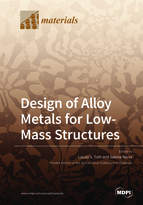Design of Alloy Metals for Low-Mass Structures
A special issue of Materials (ISSN 1996-1944).
Deadline for manuscript submissions: closed (31 July 2018) | Viewed by 111931
Special Issue Editors
2. Institute of Physical Metallurgy, Metalforming and Nanotechnology, University of Miskolc, Miskolc, Hungary
Interests: mechanics of materials; polycrystal plasticity; crystallographic texture; strain hardening; nanomaterials by severe plastic deformation; multilevel modeling
Special Issues, Collections and Topics in MDPI journals
Interests: couplings between phase transformations; modelling, numerical simulation and experimental validation; prediction of internal stresses and deformations during heat treatment of metallic alloys; metal matrix and ceramic matrix composites
Special Issue Information
Dear Colleagues,
These days, 25% of all materials used are metals and this percentage is not expected to decrease as they are indispensable for many applications due to their high resistance to temperature. The only handicap of metals is their relatively higher density with respect to modern composites. It is possible to lighten metallic structures in three ways: (1) employ low-density metals; (2) develop new ones; (3) increase the yield strength of existing high-density metals. The Laboratory of Excellence of the Lorraine University in France, called ‘Design of Alloy Metals for Low-Mass Structures’ is working towards lightening metallic structures by metallurgical means. Two leading research laboratories compose this Laboratory of Excellence within the Lorraine University: the Laboratory of Microstructure Studies and Mechanics of Materials (LEM3), based in Metz and the Jean Lamoure Institute (IJL) located in Nancy. In this Special Issue, they report some of their significant progress in different fields of metallurgy and mechanics of metallic materials. There are articles in the three major fields of metallurgy; physical, chemical and mechanical metallurgy. All scales are covered: from atomistic studies to real-scale metallic structures.
Prof. Laszlo S. TothGuest Editor
Manuscript Submission Information
Manuscripts should be submitted online at www.mdpi.com by registering and logging in to this website. Once you are registered, click here to go to the submission form. Manuscripts can be submitted until the deadline. All submissions that pass pre-check are peer-reviewed. Accepted papers will be published continuously in the journal (as soon as accepted) and will be listed together on the special issue website. Research articles, review articles as well as short communications are invited. For planned papers, a title and short abstract (about 100 words) can be sent to the Editorial Office for announcement on this website.
Submitted manuscripts should not have been published previously, nor be under consideration for publication elsewhere (except conference proceedings papers). All manuscripts are thoroughly refereed through a single-blind peer-review process. A guide for authors and other relevant information for submission of manuscripts is available on the Instructions for Authors page. Materials is an international peer-reviewed open access semimonthly journal published by MDPI.
Please visit the Instructions for Authors page before submitting a manuscript. The Article Processing Charge (APC) for publication in this open access journal is 2600 CHF (Swiss Francs). Submitted papers should be well formatted and use good English. Authors may use MDPI's English editing service prior to publication or during author revisions.
Keywords
- metal
- metallurgy
- light-weighting
- alloy design
- microstructure control
- process design
- mechanical behavior
- multi-scale modeling
- simulation








